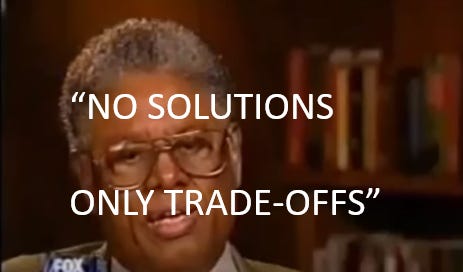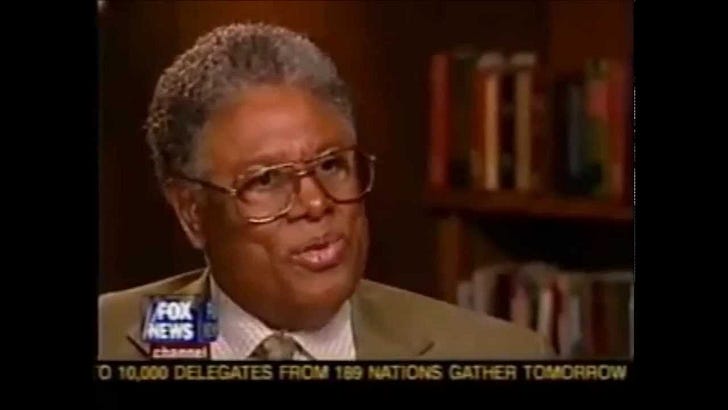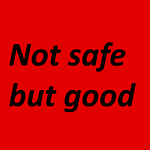“There are no solutions, there are only trade-offs; and whatever you do to deal with one of man’s flaws leads to another problem. You try to get the best trade-off you can get, and that's all you can hope for.” - Thomas Sowell
Three days ago I watched a profound, eighty-two second long video. I immediately scrapped the article I was writing and pivoted to a new topic. In the video, the famous economist Thomas Sowell alludes to a skill I find extremely rare in our society - the ability to perform a cost-benefit analysis. If YouTube is still around in a decade (the Lindy Effect predicts it should be), I’m going to have my son watch this video. Take a look:
Okay, if you were expecting a video worthy of TikTok, you were probably underwhelmed. Or perhaps because the words “liberal” and “conservative” were uttered you got distracted or lost interest. Forget about all that! Intrepid Lifers aren’t concerned with what’s trendy or politics, we’re interested in substance and how to live well. And on that subject, Mr. Sowell has much to teach us.
Cultivating the ability to think critically is a cornerstone of The Intrepid Life. I’m convinced that a mind equipped to think critically is necessary for living courageously, resiliently and free. In a day and age with few wise men, Thomas Sowell stands out (I highly suggest his book, Basic Economics). And in that snapshot of a video, like a sage investor sharing a “hot stock,” Sowell shares with us a critical thinking mental model - there are no solutions, there are only trade-offs.
This simple concept is likely not surprising. We live in a less-than-perfect world, with less-than-perfect people, so it goes without saying that there’s nothing perfect. When Sowell says there are no solutions, he means there are no perfect solutions; no magic potions, no silver bullets. But instead, every potential solution has its own consequences and knock-on effects.
Faced with this reality, when making decisions and solving life’s problems, we are forced to chose between options. Sometimes we choose between good options, other times between bad options. Regardless of the cards we’re dealt, we must be able to work through that decision-making process and to do that we need a skill that’s not taught in our culture.
The skill is what some people call “weighing the pros and cons.” I prefer to call the process a “cost-benefit analysis,” because that name highlights more clearly the reality that actions always have both…you know…costs and benefits. There is no way to get only the benefits and no costs.
I bet all of us have been advised to weigh the pros and cons when faced with a decision at some point in our life. But how many of us have been instructed on how to work through that processes? Not many of us. If any. Seeing how decisions are a part of our everyday lives, it’s probably something we should put effort into learning. Because I think it’s important, I’ve put some thought into it, and here’s five steps that I‘ve learned:
Ground yourself in reality - perfect solutions don’t exist.
Ask quality questions to identify costs and benefits.
Figure out the second and third order consequences of each solution.
Weigh the probabilities of each option.
Act.
First, we must ground ourselves in reality and accept the fact that everything has costs, even the most beneficial things. Consider that even Jesus says his free gift of salvation comes with costs. As people tend to say, “there’s no free lunch,” “there’s no perpetual motion machine,” and “money doesn’t grow on trees.” Only then can we take the next step and honestly breakdown and identify those costs and benefits.
Often benefits are obvious and hard to miss. While humans often have a habit of missing or ignoring the costs. This bent is unfortunate because an unforeseen cost can be vastly more consequential than an unforeseen benefit. Thus we must become acutely skilled at rooting out costs.
The key to identifying the costs of a potential solution is asking good questions. This will help us pick apart a problem and see it from multiple angles. The classic “5 W’s - who, what, where, when, and why - are a good starting place. Some less mainstream questions you can ask are: “what are the incentives at play?” and “does this or that option have a proven track record?” One question I find particularly helpful (and that Sowell actually mentioned in the short video) is “compared to what?” To prompt more questions, it’s helpful to step back and consider your situation from other people’s perspective.
After laying as many of the costs and benefits out on the table, take the thought process a couple steps deeper by fleshing out the second and third order affects. This skill is often considered a mental model all on its own and is an invaluable. Like Newton’s first law instructs us - for every action there is an equal and opposite reaction - nothing we do transpires within a vacuum. All of our decisions and actions will have cascading affects and our job in this step of the process is to predict as many of them as possible.
Having shown light onto as many potential costs and benefits and their consequences, it’s time to attach probabilities to each possibility. Over the past four years, in my quest to grow as an investor, I’ve tried to find and learn from the best in the field. One common trait I’ve observed in the top investors such as Jim Rogers and Doug Casey is the ability to think in probabilities. This trait has come in handy as I’ve applied it in and out of financial decisions. For example, a solution with a high cost but low probability is far different than a similar cost with a low probability. Having analyzed the possible solutions through the first four steps, the last step is the most important.
Taking action is the last step of the process. Because there are “no solutions only tradeoffs,” without a deliberate decision-making process it’s easy to be paralyzed. One common saying that helps overcome this paralysis is “an eighty percent solution is better than no solution.” Any decision process worth its salt must lead to action. (Stay to the end of the article to learn about an Intrepid Lifer who’s taking action!)
Our culture promotes solutions without discussing their costs. From topics as far ranging as fossil fuel use and responses to pandemics, socially accepted solutions are pushed and discussion of potential costs are censored. This is lunacy and will have dire consequences. Our culture will only change if us as individuals begin to think and act differently. When we’re faced with problems, and are looking for solutions, we should remember Thomas Sowell’s words, “there are no solutions, only trade-offs.” Don’t fall for solutions that purportedly have no costs. Do your own research. Make your own deliberate decisions. And change the culture one individual at a time.
Now get out there and courageously live an unsafe, but good life.
If you enjoyed learning how to use a mental model to think critically, please do me a HUGE favor by simply clicking the LIKE button. A one second investment of your time can pay dividends to the work I’m to doing with The Intrepid Life!
Intrepid Lifer Shoutout:
Speaking of living courageously…I want to give a big shoutout to a friend, and fellow Intrepid Lifer who’s taking action. This bud of mine was a inspiration when I began writing The Intrepid Life and he helped me get through the “just get started” stage. The list of men I have utmost respect for is short…and this man is on it. Because of that, I’m stoked to introduce his new YouTube channel where he is chronicling his journey learning a disparate array of cool skills. Give his first video below a watch to get inspired to get out there, take action, and get it done.












Share this post